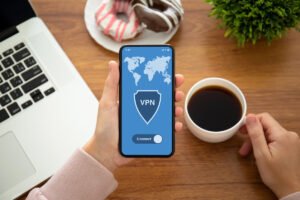With increasing advancements in smart home technology, homes are now becoming more than just a place to live in. Along with living in your house, these smart home gadgets allow you to interact with it as well.
They are rapidly growing in popularity and recent forecasts show that the number of smart homes in the United States is expected to cross 77 million by 2025. If you’re someone who’s interested in these products, you can save yourself a lot of time by simply looking for the Z-wave logo on the gadgets you buy.
DISCOVER: Smart Home Automation Ideas You’ll Love
What is Z-Wave?
Unlike other gadgets, Z-Wave isn’t a product or system but a wireless protocol that helps you turn your smart home dream into a reality. The Z-wave technology entered the United States in 2002 and was bought by Silicon Labs for a price of $240 million in 2018.
Z-Wave uses low-energy radio waves to enable communication between devices and ensures that they can operate with each other. This allows you to work across multiple product categories to create seamless automation within your smart home. Most smart home products are equipped with various versions of Z-Wave.
LEARN MORE: Home Automation FAQs
They come equipped with features such as the SmartStart, which allow you to experience the true potential of the smart home technology by simplifying the inclusion process of other devices. These versions include: (WARNING: TOTAL GEEKNESS INCOMING)
Z-Wave Plus
The Z-Wave Plus, also known as the Z-Wave 500 series, increases the range and battery life of the initial technology and is a commonality among current smart home products.
Z-Wave 700
The Z-Wave 700 series improved upon the gaps left by its predecessors and provides a connection range of 1 mile and a battery that can last up to 10 years.
Z-Wave 800
Their latest version, the Z-Wave 800, extends the connection range to more than 1.5 miles and is equipped with both the S2 security framework and the Secure Vault.
Z-Wave LR
The Z-Wave Long Range (LR) was announced in 2020 and aims to extend the connectivity beyond the boundaries of smart homes and really wants to compete with technologies in the commercial sector.
TRENDING: Setup An Easy and Cheap Smart Home Intercom System
How Secure Is Z Wave Technology?
One of the most important things to consider when choosing a home automation system is how secure it is. We sometimes easily forget how vulnerable our personal data is. You want to make sure that your personal data and information are safe and secure and that no one will be able to access them without your permission.
With Z-Wave technology being one of the most popular types of home automation technologies, it is also known for being very secure. The Z-Wave standard uses 128-bit AES encryption, which is the same type of encryption that is used by banks and other financial institutions. What this means is your data will be safe and secure and that no one will be able to access it without permission. In addition to that, Z-Wave devices are also equipped with tamper-resistant hardware, so even if someone tried tampering with your device, they most likely wouldn’t be able to.
Why is Z-Wave Important for Smarthomes?
As mentioned, Z-Wave is a wireless protocol that communicates between devices enabling them to function together and is essential for smart homes. Z-Wave’s SmartStart feature makes installing a new device as simple as turning it on.
RELATED: Is This The Best Smart Light Bulb Camera?
When turned on, a device is automatically recognized by the network and all you have to do is follow a few prompts to connect it. In addition to the easy installation, any Z-Wave certified device can work with other Z-Wave devices, allowing smart homeowners to choose from an unlimited number of options.
How Does Z-Wave Work?
The Z-wave technology operates using radio frequency between 800-900MHz, ensuring that the communication among devices doesn’t suffer from any major interference. Unlike Wifi, these devices connect to each other, form a mesh network, and then send signals from one device to another.
However, not all such devices are capable of repeating a signal. This necessitates a Z-Wave repeater to receive and send signals from one device back to the Hub.
Z-Wave Hub and Apps
A hub is where all the behind-the-scenes actions of your smart home take place. It allows you to control and manage your smart home devices from wherever you are and can also send alerts from these devices.
Smarthome owners can use the hardware hubs from Samsung SmartThings and Aeotec to manage their devices. A great thing about these hubs is that they can also integrate with Z-Wave and other smart home technologies. Along with these, other smart hub options are compatible with Z-wave.
However, if you’re looking for a Z-Wave specific hub, then Aeotec’s Z-Stick 7 is the best option. In addition to hardware hubs, many products that are equipped with a Z-Wave kit provide apps that can be used to control these devices.
BOOKMARK THIS: Basic Smart Home Automation Tips
Z-Wave Devices
Currently, there are more than 3600 Z-wave certified products on the market and over 100 million people are using the products equipped with the many versions of Z-wave. All of these devices are compatible with each other, regardless of which manufacturer they are from. Z-Wave compatible products are available in categories such as locks, switches, thermostats, and much more.
Some of the many devices that use the Z-wave technology include:
Smart Home Integration Is The Key
Smarthomes are rapidly growing in popularity across the United States. And this means homeowners are constantly looking for devices that are compatible with each other. Searching for such devices can be a problem that many people face, but it can easily be solved by looking for the Z-wave logo on your smart devices.
Z-wave uses wireless communication protocols to help ensure that smart home devices can be integrated with one another. And this is what we want! Nothing is more frustrating than getting a new smart device only to have it not integrate with the rest of your smart home. Z-wave allows owners to work across multiple devices and make their smart home dream a reality.








